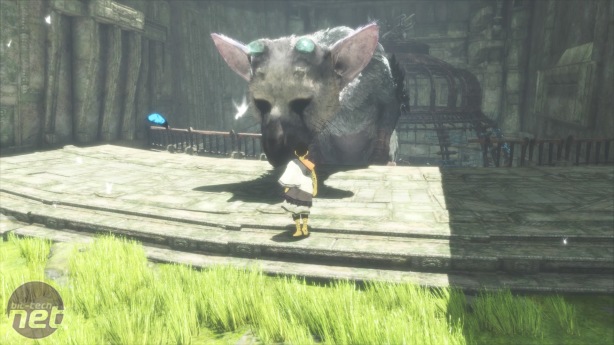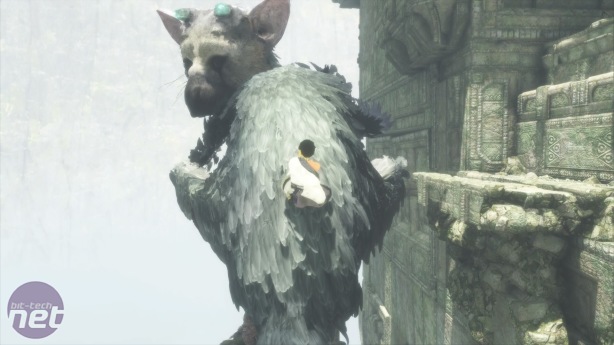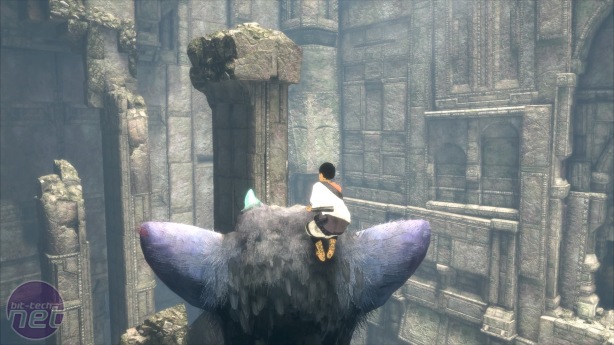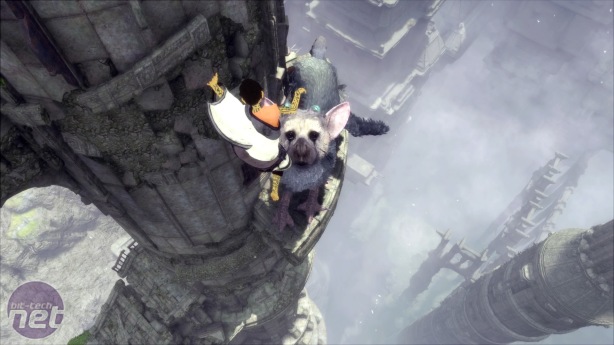The Last Guardian uses the characters’ vast differences in size and abilities to set up some ingenious spatial puzzles. Trico often acts as a mobile platform. Your character can climb onto his back and access areas that are otherwise impossible to reach. Trico can also leap onto pillars and platforms and dangle his tail down for the player to use as a rope. Meanwhile, the boy can slip through cracks and crevices that Trico cannot, such as a partly open drawbridge which can then be lowered for Trico to pass through.
To progress in The Last Guardian, not only must you look at the world through your own eyes but envision them through Trico’s as well. What may look like a jumbled line of broken pillars to you may well be a viable path forward for your feathery friend. Juggling these perspectives can have a strange effect on you too. There were times when, after examining about the world from Trico’s perspective for a while, I’d become stuck on a puzzle, and it was only when I readjusted to thinking from a human point of view that the solution revealed itself, which is a truly bizarre sensation.
The Last Guardian communicates both its systems and story with an almost unparalleled level of elegance. There’s not an objective marker or map icon in sight, while the HUD is restricted to (perhaps overly frequent) contextual control reminders. Even more impressive is the animation on both Trico and the boy, both of which are heavily reliant on physics. It’s evident that a huge amount of time has been spent ensuring Trico is able to navigate the complex world seamlessly. His illusion of intelligence is as fragile as it is convincing, and that the game manages not to break it through any animation glitches is a tremendous achievement.
The story, meanwhile, is told in a distinctly Soulsian manner. Dialogue is kept to a minimum, amounting to a few exclamations from the boy and occasional narration, which comes from the perspective of the main character looking back on events as an old man. His lyrical prose, spoken in Japanese, enhances the folkloric tone of the tale.
Otherwise the story is communicated visually through the architecture and symbolism of the world itself. While the true nature of Trico’s identity is never clarified, it is clear he is a hunted and haunted creature. The world is dotted with strange eye-like symbols rendered in stained glass which seem to hypnotize and terrify Trico in equal measure until you destroy them.
Whether these symbols were designed to ward off creatures like Trico or whether he is afraid of them for other reasons is never made clear, but it soon becomes apparent that they are linked to the eerie armoured beings that attack you on sight, as they use them as shields against Trico in combat. If they spot, you they will try to grab you and wrestle you into a dazzling, otherworldly door. If Trico spots them, he enters a fit of rage and will continue to attack even when all the enemies have been dealt with. Only by petting him gently can you soothe him back to his usual temperament.
Beneath the wonderment of The Last Guardian’s tone is a deep sense of melancholy. It’s visible in Trico’s sad eyes and sudden bursts of anger as well as in the destruction of the once-great civilisation that surrounds you. But there is also hope. The ruins occasionally give way to flourishes of verdant flora, grass and trees that dance and flutter in a lively, revitalising breeze. What’s more, through the relationship between Trico and the young boy, there is a chance that those old wounds might heal, that the rage that rises up in Trico might be exorcised for good.
For all its qualities, The Last Guardian is not without its flaws. The control system is counter-intuitive, with triangle used for jump instead of X. You do eventually become used to this, but it’s more difficult to become accustomed to the clumsiness which is inherent in the physics-driven animations of the boy. I don’t mind this so much in Trico, as he is a large and lumbering character, and the fact it takes him time to move from place to place only enhances his thoughtful nature. But I feel like the boy should be swift and nimble by comparison, yet he is often almost as difficult to move around as Trico is.
Indeed, the fact that so much of the game is physics simulated, from character animations to vegetation and even the feathers on Trico’s body, comes at the cost of performance. In a couple of later scenes, the frame rate suddenly plummets to the point where it is bordering on unplayable. Fortunately, these moments are rare, and a few frame rate dips and a slightly odd control scheme aren’t sufficient to damage what is a powerful and unique experience. The Last Guardian is undoubtedly worth the ten-year wait and a fitting way to draw what has been a generally excellent year for games to a close.
To progress in The Last Guardian, not only must you look at the world through your own eyes but envision them through Trico’s as well. What may look like a jumbled line of broken pillars to you may well be a viable path forward for your feathery friend. Juggling these perspectives can have a strange effect on you too. There were times when, after examining about the world from Trico’s perspective for a while, I’d become stuck on a puzzle, and it was only when I readjusted to thinking from a human point of view that the solution revealed itself, which is a truly bizarre sensation.
The Last Guardian communicates both its systems and story with an almost unparalleled level of elegance. There’s not an objective marker or map icon in sight, while the HUD is restricted to (perhaps overly frequent) contextual control reminders. Even more impressive is the animation on both Trico and the boy, both of which are heavily reliant on physics. It’s evident that a huge amount of time has been spent ensuring Trico is able to navigate the complex world seamlessly. His illusion of intelligence is as fragile as it is convincing, and that the game manages not to break it through any animation glitches is a tremendous achievement.
The story, meanwhile, is told in a distinctly Soulsian manner. Dialogue is kept to a minimum, amounting to a few exclamations from the boy and occasional narration, which comes from the perspective of the main character looking back on events as an old man. His lyrical prose, spoken in Japanese, enhances the folkloric tone of the tale.
Otherwise the story is communicated visually through the architecture and symbolism of the world itself. While the true nature of Trico’s identity is never clarified, it is clear he is a hunted and haunted creature. The world is dotted with strange eye-like symbols rendered in stained glass which seem to hypnotize and terrify Trico in equal measure until you destroy them.
Whether these symbols were designed to ward off creatures like Trico or whether he is afraid of them for other reasons is never made clear, but it soon becomes apparent that they are linked to the eerie armoured beings that attack you on sight, as they use them as shields against Trico in combat. If they spot, you they will try to grab you and wrestle you into a dazzling, otherworldly door. If Trico spots them, he enters a fit of rage and will continue to attack even when all the enemies have been dealt with. Only by petting him gently can you soothe him back to his usual temperament.
Beneath the wonderment of The Last Guardian’s tone is a deep sense of melancholy. It’s visible in Trico’s sad eyes and sudden bursts of anger as well as in the destruction of the once-great civilisation that surrounds you. But there is also hope. The ruins occasionally give way to flourishes of verdant flora, grass and trees that dance and flutter in a lively, revitalising breeze. What’s more, through the relationship between Trico and the young boy, there is a chance that those old wounds might heal, that the rage that rises up in Trico might be exorcised for good.
For all its qualities, The Last Guardian is not without its flaws. The control system is counter-intuitive, with triangle used for jump instead of X. You do eventually become used to this, but it’s more difficult to become accustomed to the clumsiness which is inherent in the physics-driven animations of the boy. I don’t mind this so much in Trico, as he is a large and lumbering character, and the fact it takes him time to move from place to place only enhances his thoughtful nature. But I feel like the boy should be swift and nimble by comparison, yet he is often almost as difficult to move around as Trico is.
Indeed, the fact that so much of the game is physics simulated, from character animations to vegetation and even the feathers on Trico’s body, comes at the cost of performance. In a couple of later scenes, the frame rate suddenly plummets to the point where it is bordering on unplayable. Fortunately, these moments are rare, and a few frame rate dips and a slightly odd control scheme aren’t sufficient to damage what is a powerful and unique experience. The Last Guardian is undoubtedly worth the ten-year wait and a fitting way to draw what has been a generally excellent year for games to a close.


MSI MPG Velox 100R Chassis Review
October 14 2021 | 15:04















Want to comment? Please log in.